1
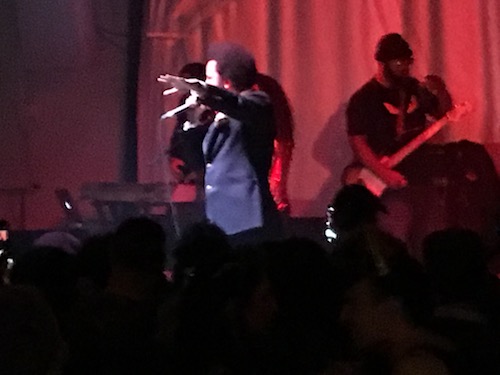
Under signs of the ruthless gangsterism of American politics, we made it to 2017, the centennial of the Russian Revolution. 1917, a land of lost left-wing dinosaurs, is a world away. It, too, was a moment of imperial degeneration. These days I often think of Jayne Cortez’s lines—
the life blood of the earth almost dead in
the greedy mouth of imperialism
—as ones of resistance. Struggles against Trump and his regime of reactionary capitalists are making the newest generation of the left visible on American streets.
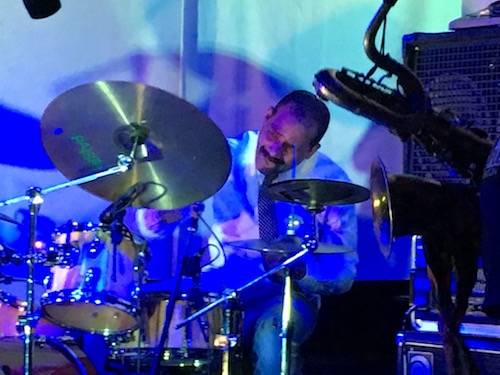
Indeed, 2017 got off to a good start. At Oakland’s Starline Social Club on New Year’s Eve, Laura, Matt, and I caught The Coup, with their legendary front man Boots Riley in rare from: spitting with charged concentration, his flow glowed between cacophony and whispers of “the sweet little angel of revolution.” He held forth in punk-guitar, hip-hop funk sonic sheets. His famed lyrics coalesce at the meeting point of black radicalism on the urban streets of neoliberal America. The Ethnic Heritage Ensemble, Kahil El’Zabar’s Chicago-based post-free jazz group, opened; this version of his ever-evolving, drum-led Ensemble’s configuration featured guitarist Fareed Haque, whose fretwork resembles something close to emancipated creativity. Starline’s big room was convulsive with percussive, attacking acoustic guitar. Big shifts in the air that night no doubt. Musical ensembles were advocates, mirrors of ad-hoc revolutionary messages and organizations.
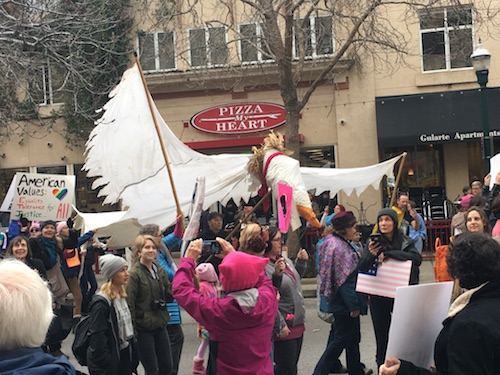
Masses are gathering in the streets. Demonstrators from anti-inauguration Friday to the Women’s March on Saturday made January an active month for people power. Trump’s travel ban from seven majority-Muslim nations also brought out direct action protests at major U.S. airports. Trump is creating situations that were recently unthinkable and an expansion of the left is possible. The energized left here in Santa Cruz where I live, with its various Marxist and Anarchist tendencies, is leading demos again and dancing down the troubles with People’s Disco nights at Bocci’s Cellar.
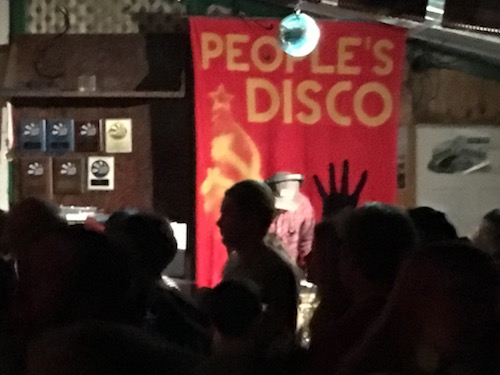
2
My first nominee for Trump era poetry reading: Ted Joans, the internationalist and Beat legend. Some have quaintly advocated for a return to the wisdom of Yeats or Stevens after the victory of Donald Trump. Against such academic suggestions, Joans represents a harder shade of black radical edge. An avowed Surrealist, he was perhaps one of the signal poets of creative and righteous twentieth-century uprisings of black people: “the millions and millions rising-up-strong been-done-wrong too-long pointing / the abused body at slumlord! War lord! Police lord! Oh Lord, all guilty and accused” (from “Passed on Blues: Homage to a Poet”). From another angle, Joans is the neglected black Beat (Bob Kaufman and Amiri Baraka are better known), a major figure repeatedly skipped over in the period anthologies.
Joans arguably epitomized the break that Surrealism represented with respect to earlier avant-garde movements. As Edoardo Sanguineti emphasizes in his essay “Surrealism Discovered Kitsch,” the Surrealists no longer considered themselves to be merely creative artists. Their “Surrealist practice” was a lived experience, and to be a surrealist is to be a creative intellectual against the times, a political traveler and actor, as Joans was in his veritable one-man international. His peripatetic life took him from the upper Midwest to New York, where he roomed with Charlie Parker, to Paris, where he befriended André Breton, and eventually to Mali’s ancient city of Timbuktu, where he kept a small mud house that was his base for the exploration of sub-Saharan Africa.
Ever present, Joans is also having something of a moment. Yuko Otomo recently concluded a two-part chronicle of Steve Dalachinsky and Otomo’s long friendship with Joans. “Let’s Get Teducated!” combines poignant memoir and criticism in frank prose that adds to our collective knowledge of its subject. CUNY’s Lost & Found Poetics Series’s recently published the two-part chapbook Poet Painter / Former Villager Now / World Traveler Ted Joans, which consists of Joans’s letters, correspondence, drawings, a screenplay, poems, and photos (including stirring angles of Joans with James Baldwin, Stokely Carmichael, Albert Ayler, and Langston Hughes). Given the limited availability of Joans’s some thirty books in the states, these new volumes are both overdue and very welcome.
The variety of the works included here is startling. What a writer in seemingly any mode! It appears to be the tip of the proverbial iceberg, as the material is culled from the 22-box archive sheltered in Berkeley’s Bancroft Library. Substantial works anchor both of the Lost & Found volumes. In Part I, the key text is the Buñuel and Jodorowsky-style Surrealist film script Negative Cowboy, which is a non-sequitur Western with heroes like Black Mollie:
She is about to attack the Wells Fargo stage again. She takes a deep drag on her marijuana pipe and digs her spurs into her handsome horse. Down the hill she comes like a black bat out of hell (in fact here in color should be a picture of a bat out of hell).
In another moment we glimpse Hemingway’s suicide after an implicit indictment of his hunting in Africa, home to Joans’s spirit animal, the rhinoceros. Later, a band of American frontier soldiers plays big band music while Native American warriors pick off the whites one by one. When a quartet of black musicians is left, the war party drags some corpses over for makeshift benches; they take in and dig the post-bop jazz. It’s all totally fucking wild! Speaking of jazz, there are several two-page souvenirs included. In one, Joans recollects the momentousness of Ornette Coleman’s first stint in New York. Joans attended the run; reception ranged from cool to hostile. “Ornette woke up New York and many reacted violently in protest,” he writes. There’s also a tribute to Lee Konitz, one of jazz’s few white innovators: “Konitz’s alto sound is light, fast and hot like a blue flame of an acetylene torch.”
The two brief selections that conclude the second volume, “Untitled Fragment” and “Excerpt from Letter to Amiri Baraka,” are especially strong. Both emanate from the 1990s, with the former a lightning-bolt May Day response to the L.A. Riots that advocates for the abolition of wage labor amid heated and even erotic juxtapositions. The fragment of a poem for Baraka is a charged epistolary coda that takes its shots at Stanley Crouch and Henry Louis Gates Jr. It reflects on Joans’s long absences from his country of origin:
I miss many merited
million male & female events
of African American in the
place of my birth, and not
because I be the ‘white-sheep’
of the ununited black family
i.e. Stain Crouch, Skipper Gates,
May-Media-Angles, all ‘serious saints’
who jes wannabe in dat number!
So, brother Baraka, I remain
as usual, outside the outsiders.
Detailed, restrained, discontinuous, which is to say alive in many directions—the lines here preserve and dignify a difficult existence, which is something close to a rule in Joans’s writings. His poem for Baraka also refers to his 1969 volume Black Pow-Wow: Jazz Poems, the book where I first encountered Joans. He called these poems “hand grenades” of the Black Power days. One of my favorites of the pithy maxim variety is “The Non-John Browns”:
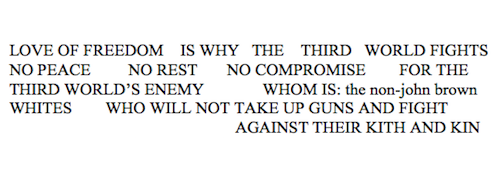
Joans’s Black Power politics was a form of proletariat internationalism; he urged broad revolutionary coalitions in the fight against American imperialism. His “Letter to Students & Workers in Paris,” from Part I of the CUNY chapbook, dates from May 1968:
As a representative of B.P. I would like to express the solidarity with the militant students, and militant workers that are in action here in France. Your enemy is our enemy, and we hope that you will destroy that same enemy here—as we will destroy it in the U.S.A. Vive le pouvoir noir vive le pouvoir etudiants vive le pouvoir ouvrier. Revolution must be made by all and not by one.
It’s enlivening to see the spirit here of radical coalition building. There is a lot of work to be done today as we must simultaneously build anew and put back together the struggles of the past. There’s no time like the present for the renewal of intellectually active and engaged poetics.
3
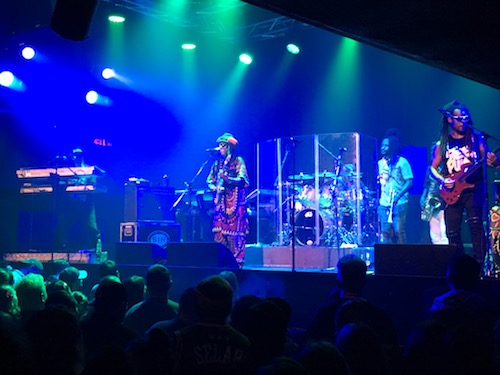
A big, diverse crowd came out for Steel Pulse in Santa Cruz on a February night. They played revolutionary songs against this neatly constructed fake world of Babylon. The surf ghettoes of the California coast are home to an extensive working-class reggae-fan base; island-like coastal cities form an archipelago of reggae-dub scenes and festivals from Long Beach to the Lost Coast. With weekly reggae broadcasts, medicinal and head shops, and many a dreadlock here in what locals call Rasta Cruz, our stretch of coast is the north end of a living fossil record: a reggae tour schedule that dates back to Bob Marley’s famous concerts from Santa Cruz to Santa Barbara. Steel Pulse maintains the tradition of positive, politically righteous music. Laura, Micah, and I heard liberation tunes sing the contemporary currents and movements: a newer cut was dedicated to Trayvon Martin. “Blues Raid Dance” opened a set of classics, including “Rally Round” and “Ku Klux Klan.” “Ravers” and “Drug Squad” shook the already lively crowd into convulsions. They had the crowd dancing hard when they covered Bob Marley’s tribute to the streets of Trenchtown, “Natty Dread.” Many cuts came off the Steel Pulse album Earth Crisis, a phrase that resonates today with renewed force as indications of a warming planet and its looming ecological catastrophe are every day more present.
4
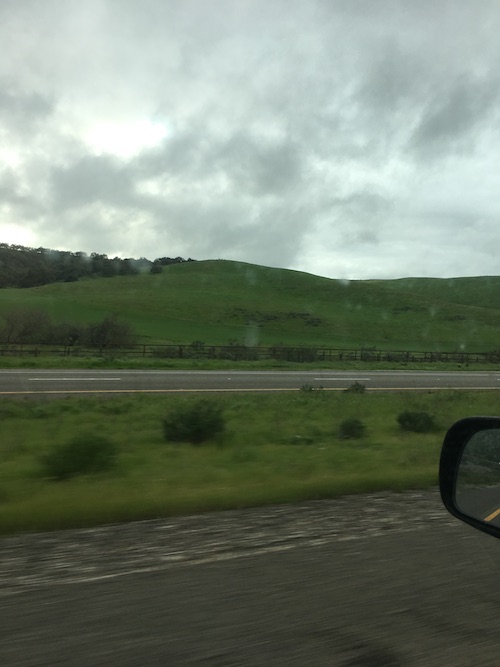
There’s been rain, rain, and still more rain—whole sheets of it dropping along storm-washed roads. Hillsides of the Santa Cruz Mountains have washed into mud and rock piles. Rains have flooded tents and trailers of the homeless in Santa Cruz and beyond. For the poor of neoliberal California, where our Democratic governor has a permanent austerity outlook, any rain is difficult. This stream of downpours comes after a half-decade of severe drought. And the infrastructure has never been ready. We saw buckled roads, trees down, freeway and road flooding in Long Beach, and eventually the Katrina-style flooding of San Jose. Some 10,000 city residents were forced from their homes.
In the middle of one of several “atmospheric rivers,” Laura and I woke up to our afternoon flight to L.A. being canceled because of rain and high winds in Southern California. Instead, we drove our son Carlos to Long Beach. Off 101, iridescent black and greenish hills, dark with wet oaks, littered wild distances in the inland hill and canyon plains. These are much-changed landscapes from the dusty, brown and red hillsides of the drought years. We drove through the storm heading south toward San Luis Obispo, where we decamped to a hotel. That night we missed L.A. and Orange County, Ventura and Santa Barbara all receiving upward of 8 inches of rain. In the morning, we continued into the L.A. basin on the 101, which was reopened after a mudslide was cleared on the coastal stretch of highway in Ventura.
We caught Picasso and Rivera: Conversations Across Time at LACMA as well as the substantial Moholy-Nagy: Future Present show. At dinner afterwards with Cal Bedient, we went over the shows’ offerings. Moholy’s photgraphs and photo collages as well as his paintings on plexi-glass were highlights for all of us. The Rivera-Picasso fills a large portion of the Broad Building at LACMA. It opens with hangings of academic studies by both artists and then moves to their Cubist paintings that closely resemble each other or rework similar subjects, from poets to still lives. Rivera’s work rewarded scrutiny and many of the Latino youth in attendance must have noticed the Mesoamerican patterns in the geometric designs from his Cubist period. The interior galleries paired later Picasso canvases with works from Greco-Roman antiquity; Rivera’s works appeared alongside pre-Columbian art, much of it from his own collection. For the curators, the two artists continued a conversation by simultaneously turning to ancient forms of art.
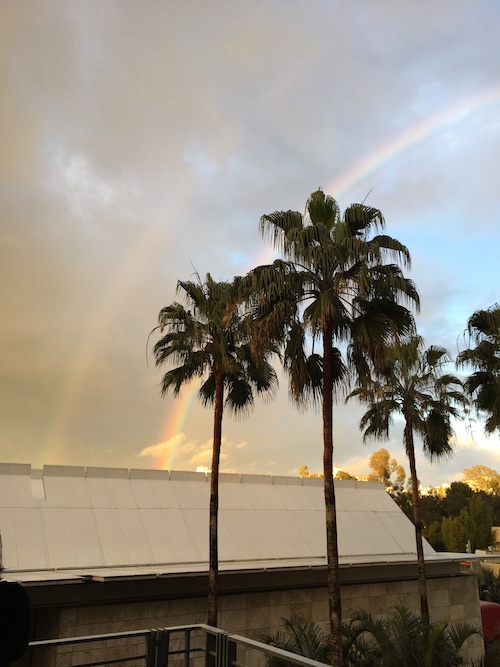
But as I looked at a preparatory sketch for Picasso’s Guernica, I thought of another way their works connected in the late-1930s context of the Spanish Civil War. As those who have studied Guernica and its composition in Dora Maar’s photos know, Picasso began painting in the spring of 1937, when the infamous outbreak of intra-left violence in Barcelona, capital of the Spanish Revolution, took place. In the early stages of its composition, the painting’s fallen hero is holding up a raised fist. This icon of the resistance was central to the Communist Party’s anti-fascist campaign. But as the Stalinist violence unfolded against the unique and indigenous far left in Spain, Picasso registered a criticism of this attack on Spanish comrades by painting the fist out of the canvas and substituting in its place a hand-held candle dangling from a window.
Rivera was himself well to the left of the Communist Party during this period. He and André Breton co-authored “Manifesto for an Independent Revolutionary Art,” a document in which Leon Trotsky also had a hand. Two salient passages appear toward the conclusion:
We believe that aesthetic, philosophical and political tendencies of the most varied sort can find here a common ground. Marxists can march here together with anarchists, provided both parties uncompromisingly reject the reactionary police patrol spirit represented by Joseph Stalin and his henchman Garcia Oliver.
and—
Every progressive tendency in art is destroyed by fascism as degenerate. Every free creation is called ‘fascist’ by the Stalinists. Independent revolutionary art must now gather its forces for the struggle against reactionary persecution.
Notice the trenchant character of anti-fascist commitment. Its level is the maximum and includes the stinging indictment of Stalin. The LACMA show needed a politics. Gone are the days of Barbara Kruger running the LACMA Lab. Today we need to gather forces and past resources to build something radical.
Later in that crystal-clear, post-rain, L.A. night, Laura and I drove to Hollywood to meet Chloe and David Buuck at a queer-friendly bar. Buuck had been in San Diego for a reading/performance with Edwin Torres and was now on his way back to the Bay Area. We chatted about poetry and politics, lamenting how little time we have to write about the new books we admire; we shared a laugh about another friend’s claims for the great artists of the postwar period. Buuck was skeptical of anyone who could leave Bob Marley off the top-three list.
5
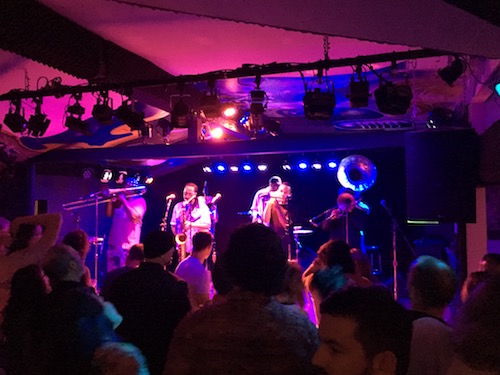
These creative mass rallies, what John Berger once called “rehearsals of revolutionary awareness,” imparted a feeling of renewal, even rejuvenation in the early months of the year. Rebirth Brass Band played a replenishing and funky end-of-February Santa Cruz show at Moe’s Alley. Just in from New Orleans, they communicated the profound cultural high of the recent Mardi Gras parade. Two mighty sets contained standards and covers of Ray Charles. Later there was a hard-stepping, double-time version of Miles’s tune “All Blues.” Rebirth brought liberated, do-watcha-wanna improvisation that mixes second line with hip-hop resonances, giving the lie to dull recycled structure of the country’s commodity culture. In the final numbers they included their elaborate signature countermelody on “Casanova.” This was music of the ongoing march and festival. That night Rebirth was what Berger called a metaphor for “total collective strength.”
6
Some sort of political creature on the American left was born in these years since the financial crisis and global recession. To be a part of the left was to stand up to the Obama years’ cruel defensive holding pattern of Wall Street “settlements” and expanding imperial warfare. As the only left opposition to the status quo these past years, our political groupings have punched above their weight, even gaining a certain amount of notoriety in the years since Occupy.
Santa Cruz is a small enclave city in a county that went heavily for Sanders in the Democratic Primary. In November, Trump received a meager 17% of Santa Cruz County returns. Political conflicts take different shapes in this context. Activists from the labor left, the far left, and environmental groups are pushing back against the Democratic center of state politics. There is a struggle for hegemony of the resistance movement, one that played out on International Women’s Day.
Santa Cruz has played an experimental role in the political geography of California struggles. The baseline of theoretical development here is high. Denizens of the town include editors and contributors to Viewpoint, New Left Review, Lana Turner, Blind Field, and Endnotes. So when Marxist-feminist theorist Silvia Federici, the famed wages for housework organizer, came back to town in the lead up to the Women’s Strike, she commanded quite a crowd at the Louden Nelson Center. Federici has long organized and theorized around the exploitation of reproductive labor in the household and society; she holds this sphere of reproduction to be central to the fight against capitalism as reproductive labor makes possible other forms of wage work. The wages we are demanding from the employers are already ours, she reiterated several times, reminding the crowd that wealth is the product of the working masses, both waged and unwaged. She emphasized the need to maintain our struggles through positive forms of social organization that foreground reproductive labor.
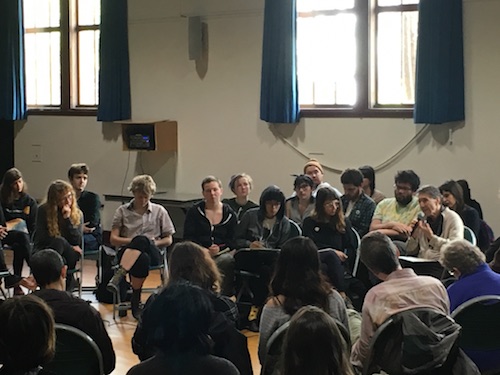
The West Coast would seem the zone to experiment with new forms of organization that defend communities targeted by the Trump Administration. We need them sooner than we know. On February 13th Santa Cruz city police coordinated a Homeland Security raid in the Live Oak neighborhood, bringing out the SCPD’s military surplus vehicle for the occasion. Announced as a gang and street terrorism arrest action targeting MS-13, the raid's goal was intimidation of the Latino working class, which sprawls out in micro-barrios, from the San Lorenzo River flats and beach flats and then all the way to Live Oak and Capitola. Days later, mayor Chase and police chief Vogel failed to explain the raid away. They claimed it was ruse on the part of DHS, which detained many people who are not connected to gang activity and who face only immigration-related charges. Police and DHS conducted the raid at a large housing complex where arrests were made indiscriminately. City Council member Sandy Brown, who was elected with support from the left here in town, uncovered the fact that city police share office space with DHS officers. As people are forcibly detained and separated from family and community, it becomes clear that the cops, DHS, and ICE are themselves the real gang. Theirs is the officially legitimized crime.
In this context, March 7th saw a protest against Granite Construction, whose headquarters are in Watsonville. Granite has bid on the Trump Border Wall; it is also a large employer in a Latino and immigrant majority city. The very next day was International Women’s Day, the day a century ago around which the February Revolution of 1917 began in Russia. In The History of the Russian Revolution, Trotsky writes: “Not a single organization called for strikes on that day […] however, in spite of all directives, the women textile workers in several factories went on strike, and sent delegates to the metal workers with an appeal for support,” thus beginning the upheaval; later: “the initiative [was] taken of their own accord by the most oppressed and downtrodden part of the proletariat – the women textile workers, among them no doubt many soldiers’ wives. The overgrown breadlines had provided the last stimulus.”
Here in 2017, the Women’s Strike faced down a menacing, misogynistic Presidency and Congress. The day’s events underlined the fundamental necessity of reproductive labor and women’s roles in all aspects of society. The concerted push from below evident in the streets is reconstituting political organs and creating new openings. The archetypal leaders here in Santa Cruz are young people. They are picking up the revolutionary threads of the past and tying a new knot today.
7
The righteous anger of the oppressed is a mobilizing force. This historical feeling plus wise humor and bizarre collage could characterize the strong tones of Jayne Cortez’s poems. Here we are far from old-fashioned MFA-experience poetry or dry experimentalism’s rehash of postmodern clichés. Instead, we come into the landscape and bluescape of Cortez, another Surrealist and also a close friend of Ted Joans (they once published a book together). She is a vital poet for the Trump era. Cortez’s work receives attention in a recent collection of academic articles on both Cortez and Adrienne Rich called Jayne Cortez, Adrienne Rich, and the Feminist Superhero, edited by Laura Hinton. The assembled essays mostly treat individual volumes or poems by Cortez. They form part of an expanding critical context for Cortez’s work as poet, activist, and performer.
Her lines, like those with which I began this essay, are memorable. They are also contexts for performance ad-libbing and invention. Her poems revive and work with sound, as do her band mates The Firespitters, a point taken up by Jennifer D. Ryan-Bryant in her analysis of Cortez’s 80s poem “Samba Is Power.” As with music, here verbal repetitions build space and form in the poem from the 1996 collection Somewhere in Advance of Nowhere:
I sambaed into the corner of handcuffed
Afro-Brazilian men
sambaed next to women who were
spinning pulsating & assaulting police cars
As Laura Hinton notes, “a certain performance power is structured into the language of Cortez’s written text.” Hinton also goes into a thicket of post-structuralist analysis where I will not follow her except to say contra Hinton: one must explain Cortez’s poetry with foregrounded reference to the Black Arts and Surrealist traditions, as they are both vital ways to communicate her poetry to a wider audience of young militants seeking black radical, labor, and Marxist-feminist traditions.
In this spirit, I’ll conclude with the Cortez classic “There It Is” from Firespitter. It is a haunting reminder of the political stakes for the left and its cause of human emancipation, both the odds it faces and the rational necessity of the struggle:
And if we don't fight
if we don't resist
if we don't organize and unify and
get the power to control our own lives
Then we will wear
the exaggerated look of captivity
the stylized look of submission
the bizarre look of suicide
the dehumanized look of fear
and the decomposed look of repression
forever and ever and ever
And there it is
And if we don’t struggle, we will be ground down ever further by the post-crash phase of neoliberal capitalism. There it is. Days of resistance lie ahead, including May Day rallies. The early years of this century are marking out new dynamics of political struggle. Like Cortez’s intrepid, dialectical poems, negating the clichés of racism in “Samba Is Power,” our task is to reconstitute, preserve, and fight for our communities. In the wake of the financial crisis of 2008 and the crisis of neoliberal capitalism as a project, racist class power is everywhere with its predations and “reforms.” From the war on drugs’ renewal under Jeff Sessions to a world of intensified deportations, policing, and surveillance under Trump, diverse communities are under the gun. Against such a backdrop, Cortez offers a poetics of the urban-social epicenter. As a measure, it is a frustrated, playfully militant counter-maneuver against the grinding forces of big capital’s war on the poor. These are poems to read with amplification at the demo. Get a fiery band.
January-March 2017
Poet David Lau grew up in Long Beach, California. He has described his family as a “Chicano-Chinese ...
Read Full Biography

